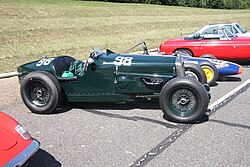Wolseley Hornet (1930)
|
Wolseley Hornet Wolseley Hornet Special |
|
|---|---|
| Production period: | 1930-1936 |
| Class : | Lower middle class |
| Body versions : | Sedan , coupe , roadster |
The Wolseley Hornet was a light passenger car manufactured by the Wolseley Motor Company from 1930 to 1936.
Hornet
| Hornet (1930-1936) | |
|---|---|
| Production period: | 1930-1936 |
| Body versions : | Limousine , coupe |
| Engines: |
Otto engines : 1.3-1.4 liters (34.5 kW) |
| Length: | 3493 mm |
| Width: | 1372 mm |
| Height: | |
| Wheelbase : | 2299 mm |
| Empty weight : | |
It had a small in-line six-cylinder engine with a capacity of 1271 cc and an overhead camshaft ( SOHC ) and hydraulic brakes. The machine was redesigned in 1932 so that it was shorter and could be installed further forward in the chassis. In 1935 the engine's displacement was increased to 1,378 cm³. Initially, the car could be ordered from Wolseley as a closed sedan with a steel or Weymann body or as a two-seater. Some of the Weymann bodies were produced by Surbico , while sporty versions were made by Abbey Coachworks . From 1931 it was also available without the limousine body and it was used for various sports car bodies. In 1932 factory-made coupés with 2 or 4 seats were added. In the last year of production there was only one standard sedan and one coupé.
The earliest copies had a three-speed transmission, from 1932 there was a four-speed transmission, which was also synchronized from 1933. In 1934 a freewheel could also be ordered.
The engine of the Hornet was also found in the MG models Magna F / L and Magnette K / N .
A total of 31,686 Hornets were built in 7 years.
Hornet special
| Hornet Special (1932-1935) | |
|---|---|
|
Wolseley Hornet Special |
|
| Production period: | 1932-1935 |
| Body versions : | Roadster |
| Engines: |
Petrol engines : 1.4-1.6 liters |
| Length: | |
| Width: | |
| Height: | |
| Wheelbase : | 2413 mm |
| Empty weight : | |
Two sports models were also built under the name Wolseley Hornet Special . The first version, available from 1932 to 1934, had twin carburettors, higher compression and 2,307 copies were produced, including by the Swallow Sidecar Company (later Jaguar ). In 1935 there was the second version with a 1604 cm³ engine, 148 of which were built.

